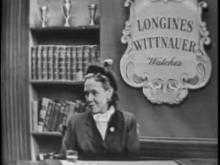Eugenie Anderson
| Helen Eugenie Moore Anderson | |
|---|---|
 | |
| United States Ambassador to Denmark | |
| In office December 22, 1949 – January 19, 1953 | |
| President | Harry S. Truman |
| Preceded by | Josiah Marvel, Jr. |
| Succeeded by | Robert D. Coe |
| United States Ambassador to Bulgaria | |
| In office August 3, 1962 – December 6, 1964 | |
| President | John F. Kennedy |
| Preceded by | Edward Page, Jr. |
| Succeeded by | Nathaniel Davis |
| Personal details | |
| Born | May 26, 1909 Adair, Iowa |
| Died | March 31, 1997 (aged 87) Red Wing, Minnesota |
| Political party | Democratic Party |
| Spouse(s) | John Pierce Anderson |
| Children | Hans, Johanna |
| Profession | Diplomat, Politician |
| Religion | Methodist |
Eugenie Anderson (May 26, 1909 – March 31, 1997), also known as Helen Eugenie Moore Anderson, was a United States diplomat. She is best known as the first woman appointed chief of mission at the ambassador level in US history.[1]
Personal life
Helen Eugenie Moore was born on May 26, 1909, in Adair, Iowa, one of five children of Rev. Ezekial A. Moore, a Methodist minister, and his wife, FloraBelle. She concentrated in music as a student, and attended the Juilliard School in New York; her original hope was to become a concert pianist. She was a member of the Iowa Beta Chapter of Pi Beta Phi Women's Fraternity at Simpson College. She married John Pierce Anderson in 1929 and had two children, Hans and Johanna.[1]
Public life

Anderson's interest in international affairs had been stirred by a trip to Europe in 1937, where in Germany she first saw a totalitarian state in action, as she recalled. On her return she spoke frequently for the League of Women Voters, fighting the strong isolationist policies of the time.[1]
Anderson helped to create the Minnesota Democratic-Farmer-Labor Party in 1944. Four years later, as one of the few women, she was elected to an office in the national Democratic Party. In 1948, as the DFL split from the national Democratic Party in a controversy over goals and ideology, she supported Hubert H. Humphrey. She was rewarded for this support in 1949, when she was appointed by President Truman as U.S. ambassador to Denmark (1949–1953).[2][3] Truman's appointment made her the first woman appointed chief of mission at the ambassador level in US history.[4] (The first female chief of mission at the minister rank was Ruth Bryan Owen in 1933).
She was later appointed by Kennedy to be ambassador to Bulgaria (1962–1964).[5] Thus Anderson became the first American woman to represent the United States in a country allied with the Soviet Union.
After her retirement from these posts, President Johnson appointed Anderson to the United Nations Trusteeship Council and a year later she served on the United Nations Committee for Decolonization.
References
- ↑ 1.0 1.1 1.2 Binder, David (1997-04-03). "Eugenie Anderson, 87, First Woman to Be U.S. Ambassador". New York Times. Retrieved 2008-03-31.
- ↑ "Eugenie Moore Anderson". Eugenie Anderson Papers. Minnesota Historical Society. Retrieved 2008-03-31.
- ↑ "United States Department of State: Ambassadors to Denmark". United States Department of State. Retrieved 2008-03-31.
- ↑ "Women in Diplomacy". Bureau of Resource Management, United States Department of State. November 2005. Retrieved 2008-03-31.
- ↑ "United States Department of State: Ambassadors to Bulgaria". United States Department of State. Retrieved 2008-03-31.
- Lamson, Peggy (1968). Few Are Chosen: American Women in Political Life Today. Boston: Houghton Mifflin.
- "Helen Eugenie Moore Anderson". The Political Graveyard. Retrieved 2008-03-31.
External links
- A film clip "Longines Chronoscope with Mrs. Eugenie Anderson (November 7, 1951)" is available for free download at the Internet Archive [more]
| Diplomatic posts | ||
|---|---|---|
| Preceded by Josiah Marvel, Jr. |
U.S. Ambassador to Denmark 1949–1953 |
Succeeded by Robert D. Coe |
| Preceded by Edward Page, Jr. |
U.S. Ambassador to Bulgaria 1962–1964 |
Succeeded by Nathaniel Davis |
|